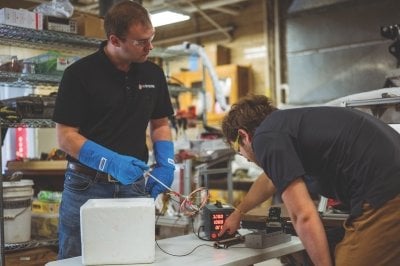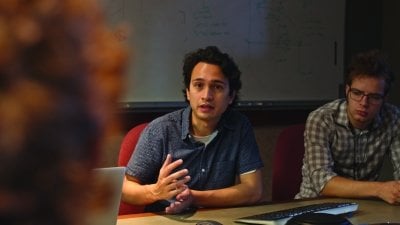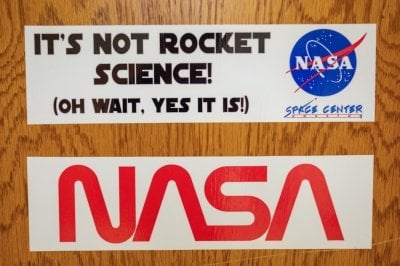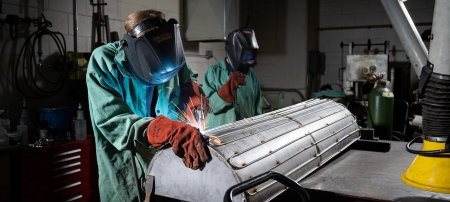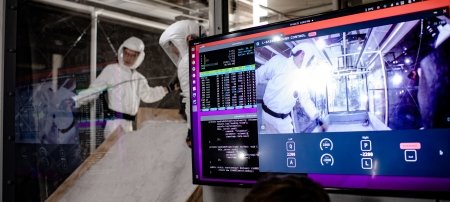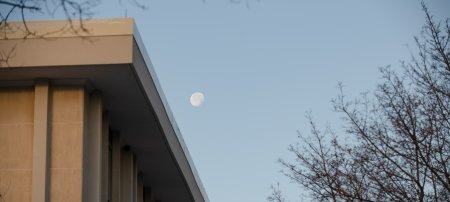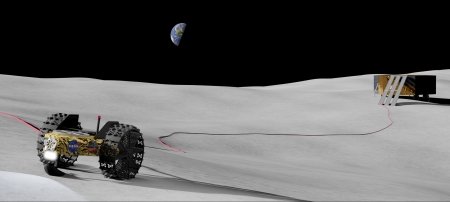Michigan Tech's Planetary Surface Technology Development Lab is making a name for itself in the aerospace industry with innovative ideas and engineering prowess. We shadowed the PSTDL team for a year to learn the secrets of their success.
February 6, 2023
It's 5:58 p.m.—two minutes to game time—and the Flat Moon Society is only just beginning to show signs of panic. Team captain Travis Wavrunek '20 '21 '24 scans the snow-covered Walker Lawn anxiously, looking for the team's regular goalie, Chuck Carey '22 '23, who is clearly running late. Other Society members huddle to revise their positioning and strategy. The referee blows the whistle, summoning players to the ice. The expression on Travis's face shifts from anxiety to resignation. Despite being one of the team's top scorers, he will have to fill in as goalie until Chuck arrives.
The Flat Moon Society is the broomball team of the Planetary Surface Technology Development Lab, or PSTDL, a group of space-obsessed graduate and undergraduate students at Michigan Tech who compete in a variety of NASA Centennial Challenges. The series of competitions offer financial prizes for devising technology that helps advance NASA's goal to support a sustained human presence on the moon. The PSTDL fields teams in the Watts on the Moon Challenge, a renewable energy competition focused on lunar power management, distribution, and energy storage solutions; the Break the Ice Lunar Challenge, which aims to excavate icy lunar regolith and deliver it to a hypothetical processing plant for use as water; and more than half a dozen other projects that address the technological challenges of space exploration.
Broomball is neither these students' top priority nor their obvious strength—but it is the perfect sport for Michigan Tech, historically known for producing talented engineers like them. A union of chaos and comedy, broomball serves as a communal stress-release valve, embraced by serious students who tend toward reason and order. The sport has been a Tech tradition since the 1950s. Like hockey with brooms but without the skates, broomball has a way of quite literally leveling the playing field, humbling everyone who ventures out onto the ice. Even the best broomball players, who master the sport's unorthodox laws of thermodynamics, spend much of each game sliding on their knees or floundering on their backs. Occasionally a ball ends up in the goal. The sport's mantra could be a twist on the famous Samuel Beckett line: Try again. Flail again. Flail better.
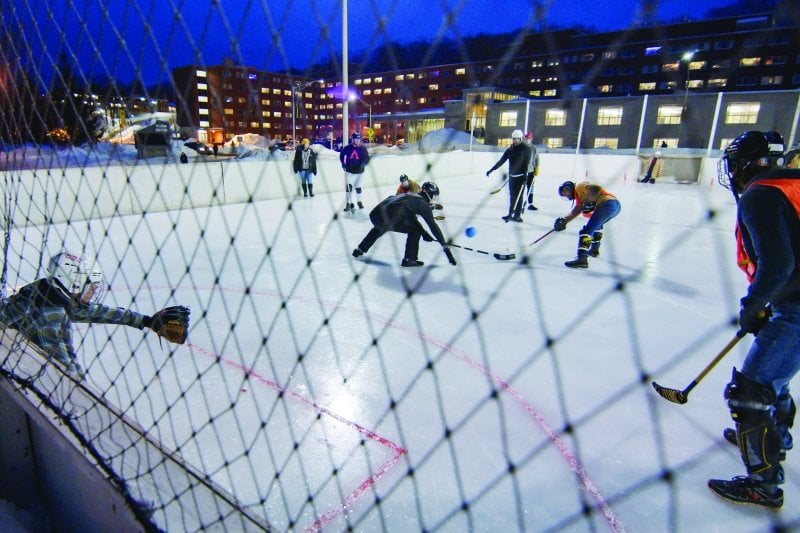
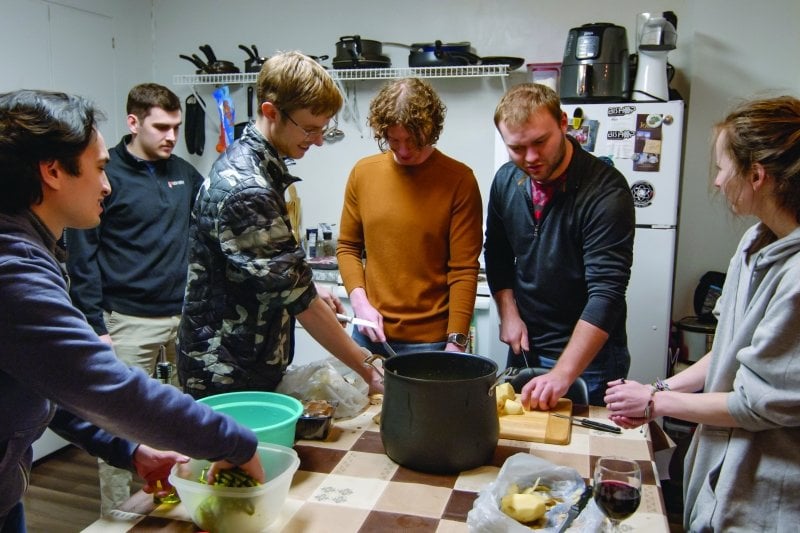
PSTDL members say cooking nights, camping, and broomball are the heart of the team's success. "I consider everyone on the team a friend, and you don't want to disappoint your friends when it comes to making your commitments," says Chuck Carey '22 '23. "When you say, 'Oh, I'm going to get this thing done,' it's not just Jerry from work. It's my friend Travis who needs this done, so I'm going to do whatever it takes so I don't disappoint my friend."
For the Flat Moon Society, broomball is just a thing they do together for fun, like cooking, traveling, camping, and hiking. In this game, Travis puts up a valiant effort as a backup goalie, but allows two goals. Chuck shuffles in late from his ski patrol shift at Mont Ripley, then gives up four more goals in the second half. The Flat Moon Society loses 6-0. Team members spend an inordinate amount of time after the game analyzing their loss.
Forty-eight hours later, after two all-night marathon sessions of cramming data and completing last-minute tests of their engineering designs, the PSTDL Watts on the Moon team will submit their Phase 2, Level 2 design to a group of NASA judges. Five months later, the judges will award the team $400,000 dollars and a spot in the final round of the competition.
The team's success is impressive but hardly surprising. Although their broomball record puts them squarely in the middle of the intramural pack, their record in aerospace engineering competitions is in a class of its own.
In NASA's Breakthrough, Innovative and Game-changing (BIG) Idea Challenge in 2020, the PSTDL team won the top prize—the Artemis Award—for the Tethered permanently-shadowed Region Explorer rover, nicknamed T-REX, which they designed to explore the permanently shaded regions of the moon. They then marched through three rounds of the Watts on the Moon Challenge to the finals, expanding on their original T-REX technology and winning against teams from other universities and private industries. In the final round of the competition, which will conclude in summer 2024, the team will get the chance to test their hardware in a thermal vacuum chamber at NASA Glenn Research Center in Cleveland, Ohio. The winner will take home the $1 million grand prize.
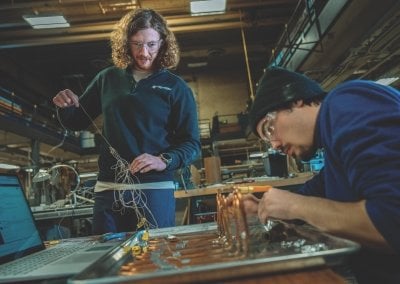
The ultimate goal of the PSTDL is to send technology first engineered at Michigan Tech all the way to the moon. To that end, they go above and beyond, designing their innovations for the Centennial Challenges, but advancing them to NASA technology readiness levels, or TRLs, rarely achieved in university labs. They're able to do so thanks to the central feature of the lab: the Dusty Thermal Vacuum Chamber, which is partially filled with simulated lunar dust, or regolith. Temperature in the chamber can reach a low of negative 196 degrees Celsius and a high of 150 degrees Celsius. The chamber is an attractive feature for aerospace companies, most of whom lack access to a dusty thermal vacuum chamber and are looking to test their technology in lunar conditions.
As astounding as the PSTDL team's achievements are, perhaps more impressive is their humility. From lower-division undergrads all the way up to Assistant Professor Paul van Susante, the lab's director, team members are confident but modest, and sometimes just plain bashful. Despite their many victories, they do not flaunt their wins individually or as a group. You would be hard-pressed to distinguish any one of them from the average messy-haired, sleep-deprived college student, and if you caught them in the corduroy blazers some of the Flat Moon Society players wear as broomball jerseys, you might think they excel only at being ridiculous. Yet in all things but broomball—and sometimes even in broomball, they would have you know—this motley group of self-described space nerds do one thing and do it well: They set ambitious goals for themselves—and they achieve every single one.
Six months before the 6-0 broomball defeat, when Phase 2, Level 2 of the Watts on the Moon Challenge began, there was little doubt on campus the PSTDL team would advance to the competition's final round. The question was never if they would succeed. The question was how they succeed—again and again and again.
August 31, 2022
The Watts on the Moon team's first group meeting of the 2022-23 academic year takes place on the last Monday in August. Team members slowly trickle into the ninth-floor conference room in the MEEM—or the R. L. Smith Building to those unfamiliar—ahead of the 4 p.m. start time. The T-shirts and hoodies they wear and the stickers adorning their laptop computers uniformly rep the clashing colors of the same three brands: NASA's red, white, and blue; Michigan Tech's black and gold; and the PSTDL's own black, gray, and orange. Paul makes small talk with the students who worked in the lab over the summer. Travis taps his foot nervously and looks at the wall clock. Others sit silently around the conference table, reluctant to speak.
When the first images from the James Webb Space Telescope were released by NASA in July 2022, the rest of the world quickly caught on to what the PSTDL team already knew: Space was hot again. Major newspapers began livestreaming SpaceX launches on their homepages. In August, India landed the Chandrayaan-3 spacecraft near the lunar south pole. Columnists and pundits speculated that the US had entered a new space race with China, one we were maybe winning, maybe losing, depending on how progress was measured and victory declared. Suddenly, public enthusiasm for all things space exploration reached levels not seen since the 1960s.
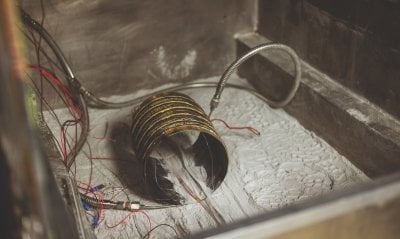
The major catalyst for all this buzz? NASA's Artemis program. Formally established in 2017, the Artemis program seeks to build on the successes of the Apollo missions before it. However, Artemis seeks not merely to send astronauts to the moon, but rather to establish a sustainable, long-term human presence there through the use of resources found, harvested, or generated on-site. The program has five missions—two uncrewed, three crewed—scheduled before 2030, and if all goes according to plan, NASA will land the first woman and first person of color on the lunar surface. By 2029, the moon could serve as a living laboratory in space and a springboard for future human missions to Mars.
Ambitious goals indeed—the perfect kind for a bunch of stargazing Michigan Tech engineers, many of whom intern for NASA and for affiliated private sector companies working to develop Artemis mission technology.
As space continues to have its moment in pop culture, aerospace is quickly becoming a polestar in Michigan Tech's engineering cosmos. Orbion Space Technology, a Houghton-based company and leading player in the small satellite revolution, employs 40 full-time engineers in downtown Houghton, many of them Michigan Tech alums. A 2019 SpaceX mission carried a Husky-built microsatellite aboard its Falcon Heavy craft: the Oculus-ASR, designed by the MTU Aerospace Enterprise team. Students in the Multiplanetary INnovation Enterprise (MINE) work on various resource exploration and extraction projects, building on Tech's historic expertise as a mining school.
At one minute after 4 p.m., Travis launches into a brief PowerPoint overview of the task ahead of the team in Phase 2, Level 2—essentially, to refine the lunar power management system they designed the year prior, which receives and converts solar power before transmitting it via superconducting tether to be stored in a battery three kilometers away. The battery then supplies power to a hypothetical lunar ice processing plant. They call their system TEMPEST—the TEthered Mechanism for Persistent Energy Storage and Transmission—and the more efficiently it operates, the more points they will score. Bonus points will be awarded to teams able to test their solutions in a vacuum chamber at the full three-kilometer distance.
Travis outlines the steps to be taken over the next six months, from designing a battery manufactured for the moon's extreme temperature and pressure conditions, to testing and optimizing various mechanisms by which the battery will store and transfer power. He also acknowledges some major constraints: namely, the persistent supply chain issues causing long lead times on essential design elements like superconducting cable and energy converters. The team will be divided into independently operating subteams—thermal, structures, conversion, battery, tether, and safety—which will communicate their progress to the team via Slack and Google Drive. Just before he begins assigning team members to their respective subteams, Travis stops, realizing that he skipped a crucial step: introductions.
Team members go around the table, stating their names and their engineering specialty, each one managing to shunt the spotlight a bit faster than the next. "Collin Miller, mechanical." "Erik Van Horn, electrical." When Brian Johnson '23, an undergrad specializing in thermal engineering, introduces himself, his voice cracks.
It's clear: The Watts on the Moon team are wallflowers, one and all. The most imposing figures in the conference room may be the overstuffed burgundy office chairs, which appear ready to swallow the team members whole.
Things that go unsaid during introductions: Hunter McGillivray '23 won two FIRST Robotics national championships in high school, which makes him the mechanical engineering equivalent of a five-star football recruit. Marcello Guadagno '19 '25 won a US Department of Defense Science, Mathematics, and Research for Transformation (SMART) Scholarship that is paying for his PhD and guarantees him a job after graduation with the US Space Force. Many of the PSTDL members were on the team that won the Artemis Award—including Travis, who has since grown from plucky undergrad to PhD candidate and team lead. Even the second-years and juniors in the room have internships and publications on their LinkedIn profiles that would make a recruiter's mouth water.
Oh, and all are full-time students. Many are also on the team competing in NASA's Break the Ice Lunar Challenge, all will be taking three weeks off in December for winter break, and a few will leave the team in January for spring semester internships.
This competition is no one's top priority. It's just one of their many aerospace side hustles.
By the time the students are done introducing themselves, the conference room is in danger of becoming a vacuum chamber itself. Reading the room, Paul wraps up the round of introductions with some deadpan humor.
"I'm Paul, the guy who pays the bills once you guys bring in the money."
Everyone laughs. The conference room exhales. For the first time all meeting, the chance of this humble team accomplishing the extraordinary feels not entirely impossible.
September 7, 2022
Marcello brings a pint of gummy bears to the next team meeting and places it in the center of the long table. He says sugar is the real secret to the team's success. True or not, by the end of the meeting, the pint is nearly empty.
Travis displays a multipage document on the screen—the Requirements Verification Matrix, or RVM—outlining the extensive criteria on which the team will be judged in this level of the challenge, as well as their progress toward completion. The criteria are formatted to match aerospace engineering disciplinary standards, but the document itself is one that Marcello and others created years earlier for an Aerospace Enterprise project. Paul describes it as a "way of breaking a big problem down into its smaller parts." It's complex, but it worked, and they've used it ever since.
Discussion ranges from nondisclosure agreements that need Paul's signature to serious inventory shortages of converters needed for their design. Hunter reports that the team only has about seven feet of dual-channel superconducting cable left on hand. The team spends a tense half hour debating if they can and whether they should purchase more cable to try and earn the three-kilometer bonus points. The more competitive members want to go for it. The more conservative members want to hold off and stick to the already daunting base challenge of Level 2: proving their system can achieve NASA's desired load cycles—just not at full scale. Paul nudges the team to the latter approach. He employs a civil engineering metaphor to do so, saying it's easy to design a bridge, but people too often forget that the pieces of the bridge must be transported to the site from where they are manufactured. Marcello, frustrated at the time being wasted on what he calls "circle talk," urges the team to go for the bonus points. Both reference the competition rules to bolster their point. Neither concedes. Paul suggests the team put together a shopping list for him, and the decision is delayed for another day.
After the meeting, the students ride the elevator down to the seventh floor. Travis punches in the key code on the locked double doors, and they duck into the PSTDL itself to continue the discussion. Above the keypad, a bumper sticker greets guests and passersby alike: "It's not rocket science! (Oh wait, yes it is!)"
October 19, 2022
At the Monday team meeting, Travis solicits updates from the various subteams while making real-time edits to the "Watts Dev Plan." The submission deadline is still four months away, but Travis is urgent, his voice feverish.
The development plan is a working flowchart of color-coded boxes, arrows, ovals, and parallelograms mapping the various tests to be completed by each subteam and setting them on a timeline. It takes what was conceptual in the RVM and illustrates it visually, showing not only the complexity of the task, but also the interdependence of the subteams. Green means done, yellow means in-progress, red means behind schedule. Travis unveiled the development plan at the team meeting two weeks ago. The dominant shade is already red due to unforeseen delays. Also, the team forgot to account for the three weeks they will lose when they go on winter break.
The cursor on the screen flickers in and out of view. Travis rattles the mouse against the table, trying to inspire it to keep up with his pace.
"When do we need to order the superconducting cable?"
"Last week."
"What about the converters?"
"Sooner than possible."
"The battery?"
"We still haven't heard from the supplier. It might be time to start trying to find a new supplier."
"Or build a new battery ourselves."
"No way."
"Okay, what has to get done now or else destroys the program?"
"CAD (computer-aided design) in three weeks."
"Thermal model in three weeks, too."
"We can't be doing the first run of any test in front of the NASA judges."
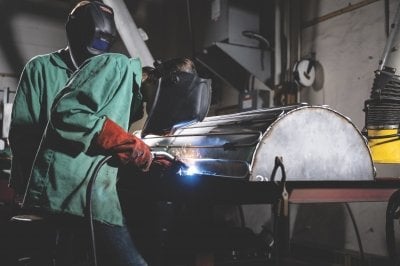
The cursor on the screen continues to flicker. Travis lifts the mouse, then glares at its recalcitrant underside. "So we finish the test and then have one week to write the paper?"
"Yes."
"When's the submission deadline?"
"February 8."
"Isn't that Winter Carnival?"
"All-Nighter."
"The night before the All-Nighter."
"So two all-nighters back-to-back?"
"Yep."
The cursor flickers again. Travis relents and slides the mouse to the center of the table. "This is just the worst mouse."
After the group chuckles, the team passes a minute in silence, absorbing the enormity of what's ahead of them. Finally, Hunter speaks.
"It looks like thermal has the least wiggle room of anything. I can build the CAD so they can get started on the model."
"Don't you have an exam tomorrow?"
"Yeah, but it's fine."
"And Break the Ice?"
"Yeah, but the CAD will only take an hour or so. I can do it. I'll make time for it tonight."
November 2, 2022
Only Travis, Hunter, and Brian show up to the first team meeting in November. Paul is traveling for work in Texas and the approaching submission deadline for Break the Ice is "eating everybody's time," according to Travis. He adjourns the meeting after letting the others know the battery company came through. It looks like that part of the project is a go, with one hitch: The battery won't arrive until January—meaning they'll have to compress their battery test schedule down from four weeks to one.
Hunter and Brian venture down to MEEM 708 to talk about Hunter's CAD design. 708 is the PSTDL workspace/lounge, a corner room on the north side of the building that looks like a hangout spot for the robots of Mystery Science Theater 3000. An ancient wooden conference table divides the room, bathed in fluorescent light and topped with napkins, nylon straps, safety glasses, Clorox wipes, a yellow measuring tape, wirecutters, mechanical pencils, a mason jar of manufactured regolith, and stickers galore, including one that says "Give Space a Chance." Desktop PCs line the walls. At the far end of the room, a plaid couch faces a whiteboard, the lower right corner of which displays the "Exploded Hardware Leaderboard," a running tally of fried electrical parts and other damaged items that confirms the importance of testing equipment before sending it to space.
While Hunter sketches his design on the open whiteboard space, he and Brian discuss a research paper they've recently discovered that details an innovative thermal design for a Mars rover. Hunter's sketch is a complex tangle of blue boxes and red arrows representing converters, switches, and pathways designed to balance and maximize the insulative and conductive properties of the TEMPEST system.
Brian observes quietly, taking it all in and making mental notes.
"Is there anything else that needs heating up and cooling down?" he asks. His tone is gentle and genuinely curious. It reveals nothing about whether he already knows the answer. His question invites Hunter to reimagine the design collaboratively, rather than defend his original design.
Soon their hands are purpled with marker ink. All traces of Brian's former shyness have disappeared. He seems to stand a bit taller with every ventured suggestion that Hunter incorporates. By the end of their whiteboard session, the design looks halfway intelligible even to the untrained eye: a stacked battery with two converters and a heat switch powered by a phase change material, likely paraffin wax. They agree the new design will be easier to model and easier to build. It should also save the team money, time, and mass, all of which will translate into a higher score.
"When working on a big project like this, communication's one of the most important things," says Brian Johnson '23. "You have so many little subteams off in their own worlds, if they're not talking to each other, you're quickly going to have problems. But everybody on this team gets along and communicates so well."
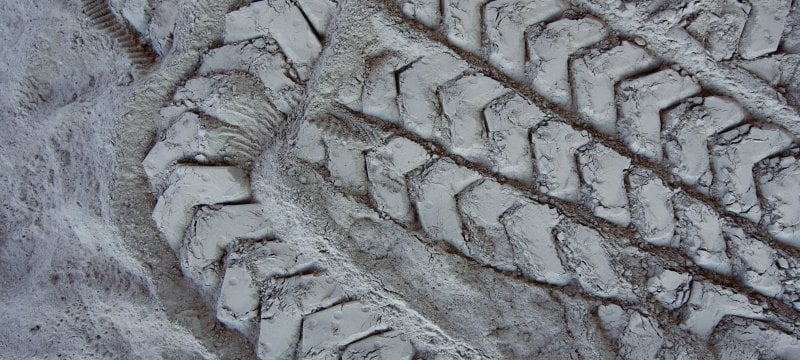
December 15, 2022
The last Monday team meeting of the year gets bumped up to the Thursday prior to account for finals week. Hanging over the meeting is winter break and everything it means for the team: Collin is graduating. Everyone is returning home for the holidays, and Brian and Erik are leaving the team for spring internships at NASA and Orbion. What was once a rather abstract anxiety is now all too real.
Travis starts the meeting by updating the development plan. Green boxes turn yellow, yellow ovals turn red. One pale-red parallelogram gets colored a new shade of red. Deep red. Blood red. Vampire red.
Hunter reports that the tether test is done. The group musters a half-hearted cheer.
"A green box ahead of schedule—imagine that," Chuck quips.
"We're making good progress, actually." Travis says this with such earnest sincerity that the words hang in the air for a moment before changing phases and entering the realm of the absurd. He laughs, realizing just how ridiculous he sounds, then plows ahead sardonically and makes a joke of it. "I mean, we're way behind—but not as far behind as we could be. So, good progress."
Talk veers from the logistical to the technical—amperage, DC power, AC, load cycles, delta T. After 15 minutes, the conversation sputters to a halt. The cursor glitches on the screen. Travis sighs and drops the mouse.
Paul asks if everyone feels like they have a task to accomplish over break.
Nodding ensues. Murmurs. Furtive glances.
Marcello studies the development plan and says he could probably take on one or two more things over break. He asks Travis what he should focus his attention on.
"Well, Marcello, what red box do you find most attractive?"
January 29, 2023
The battery arrives on the last Wednesday in January, two weeks before the Phase 2, Level 2 submission deadline. The team's priority shifts from independent subteam work to what Travis calls "full system integration." Meanwhile, three students try to disappear into the overstuffed office chairs at each Monday meeting—new undergraduate team members who seem even more bashful than the ones they replaced. They, like the power management system the team is designing, will require integration, too.
On Sunday night, the team meets for a meal at the apartment Travis and Marcello share. Hand-rolled sushi and homemade pizza have been featured at previous team gatherings. On the menu tonight: steak and duchess potatoes. Hunter and George, a PSTDL research engineer, captain the cast iron, searing a variety of cuts to each team member's preference. The others orbit the kitchen in a kind of unchoreographed culinary ballet—boiling potatoes, then blending and piping them into four dozen individual portions before baking and topping each with a sprinkle of paprika and nutmeg. Their chemistry in the kitchen mirrors how they operate in the lab: a fluid division of labor with little hierarchy or ego, and much laughter and trust.
The next day, Paul meets with Travis and Marcello to map out the work to be done ahead of the visit from NASA judges in April. A week later, the Flat Moon Society loses 6-0 in a broomball game, then turns their full attention to their 30-page Phase 2, Level 2 submission, which is currently 15 pages in length and due in less than 48 hours.
February 8, 2023
For two days, the conference room transforms into a hive of laptops, doughnuts, and hyperconcentration. Team members duck in and out between classes. George, Ben, and other lab members not on the Watts on the Moon team stop by to help, often for hours at a time. Projected on the screen at the front of the conference room is the final submission document—the culmination of six months of disparate tests, reports, and data analysis—which everyone around the table is editing simultaneously. The stress in the room is palpable but familiar, and maybe even welcome.
With less than six hours to go until the 5 p.m. submission deadline, Travis—his eyes bloodshot from two nights of no sleep—states the obvious to no one in particular: "This submission is not even close."
Paul answers, firm but calm: "Focus on what still needs to be done."
Travis sprints to the lab to run a last-minute tether test.
Marcello, having led the team in earlier phases of the competition, begins directing the flow of work—assigning tasks, redirecting side conversations. He charges Austen, a grad student, with creating a test status matrix to help further organize their data and present it in an intelligible way for NASA judges to read. He then critiques a passage of writing for its noncommittal tone. "I'm going to have an aneurysm trying to read this paragraph. Think like a judge, people. Be specific. We have to rewrite this."
"We can keep going through it," Paul says, "but in the meantime, people should be working on whatever they can, else we're going to run out of time."
Half an hour later, Chuck requests help with formatting his section of the submission. He slides his laptop to Marcello, who takes it, begins typing, and recoils at the unconventional keyboard letter arrangement. "Not on this computer! Dvorak? Chuck, why can't you just be normal?"
Chuck shrugs. The group laughs. They all get back to work.
At 11:30 a.m., Paul senses a collective blood sugar drop. "Shall I order sandwiches?"
Marcello answers for himself and the group: "Whatever you put on this table, I will eat it."
Five hours and a box of Jimmy John's later, Chuck announces that the submission is now 34 pages—four over the maximum—and the performance results table the judges will use to compare the efficiency of the TEMPEST system against those of other teams is still incomplete.
The group debates rewording the thermal section again.
"It's got to be quick, guys," Hunter says. "20 minutes."
"This is not a journal paper," Paul adds. "Tick tock, people."
Travis bursts into the room. He reports, breathlessly, that the tether test worked. Austen takes the data and begins doing calculations, while Hunter plugs the numbers into the performance results table.
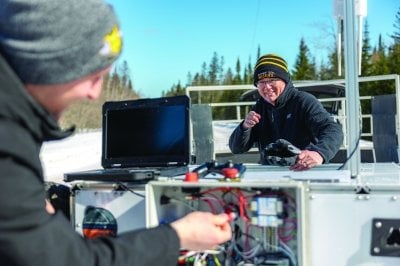
At 4:45 p.m., the submission stands at exactly 30 pages. Marcello solicits confirmation from everyone that their sections of the document are complete. Thumbs go up. Marcello exports the document, then emails the final version to Paul. In unison, the backs of the room's overstuffed office chairs flop backward in relief.
In Paul's office, Travis talks to the team on speakerphone while Paul scrolls through the document. Travis confirms that it's the right version. Paul uploads it to the Centennial Challenge website, then pauses at the final screen.
"Submit entry?"
"Heck yeah," Travis says.
Paul clicks. The screen changes. The time is 4:54 p.m.
"Congratulations!" he says, offering Travis a fist bump. "We did it. And six minutes early. Now, it's time for sleep."
Travis sighs. "I'm so full of adrenaline right now, I'm actually not that tired."
Two months after entering their submission, the team pulls one last all-nighter, this time to build out the extensive PowerPoint slide deck needed for the all-day presentation to NASA judges. With 16 hours to go, the deck is barely 20 percent done. But when the judges arrive at 8 a.m. the next day, the team looks fresh and confident, their slides professional and complete. They even have snacks and coffee prepared, as well as a gift basket of stickers, patches, and hats with the PSTDL logo, which they share with the judges during the ritual exchange of swag.
Three months later, NASA awards the PSTDL team $400,000 and names them one of four finalists in the Watts on the Moon Challenge.
So how do they do it? How does a group of spotlight-shrugging college students not only compete against private sector aerospace companies in NASA-sponsored competitions, but advance in these competitions time and time again?
Well, for one thing, the team is intensely competitive—which perhaps goes without saying for a group who stands around outside in subfreezing temperatures analyzing a 6-0 broomball defeat. They are also highly intelligent, and not just in their respective engineering specialties. Their conversation flows seamlessly between the technical and the conceptual to the logistical and the mundane, all of which they pepper with witty banter that's drier than lunar dust. They laugh frequently, and they are confident in their intelligence, but they always seem to leave their egos at the door. Everyone's ideas are welcome; none are above scrutiny, not even Paul's. Critique is accepted, even encouraged, and sometimes it escalates to levels that an unwitting observer might mistake for conflict—but it's never personal, and no one on the team appears to take it as such.
When asked about this, team members were, to a person, incredulous at the question. It's not that they've all bought into some cliche mission statement about no individual being more important than the team; it's that they've never even conceived of a world in which such a mission statement would need to be articulated. Selflessness is self-evident. Like a competition deadline, it is not up for discussion or debate—it just is.
Perhaps that's because Paul trusts his team, and thus draws the best out of each individual and empowers them to excel. Hierarchy, if it can be said to exist in his lab, is less a power structure than a safety net. Despite his expertise, even when hundreds of thousands of dollars are on the line, "the guy who pays the bills" and buys the sandwiches rarely intervenes—and even then, offers only guidance and suggestions, not solutions or rules.
Above all else, though, what makes this team so special—and so consistently successful—is a zeal that many people, old-timers mostly, say is increasingly in short supply these days. That is, members of the Planetary Surface Technology Development Lab make little to no distinction between home and work, work and school, school and play. They're space nerds—they just love space. They love aerospace engineering, and they love solving problems, and they love spending time with other people who enjoy these same things as much as they do.
Over the course of the year, when asked why they joined the lab in the first place, not a single team member mentioned doing so to gain experience for their resume or to make connections at NASA. Instead, all of them, independently of each other, answered the question just like Hunter did.
"I mean, this is what I do in my free time anyway," he said. "I figured I might as well be doing it with my friends."
Who knows? Maybe it's just college.
Maybe it's Michigan Tech.
Or maybe, just maybe, it's generational.
Michigan Technological University is a public research university founded in 1885 in Houghton, Michigan, and is home to more than 7,000 students from 55 countries around the world. Consistently ranked among the best universities in the country for return on investment, Michigan’s flagship technological university offers more than 120 undergraduate and graduate degree programs in science and technology, engineering, computing, forestry, business and economics, health professions, humanities, mathematics, social sciences, and the arts. The rural campus is situated just miles from Lake Superior in Michigan's Upper Peninsula, offering year-round opportunities for outdoor adventure.

